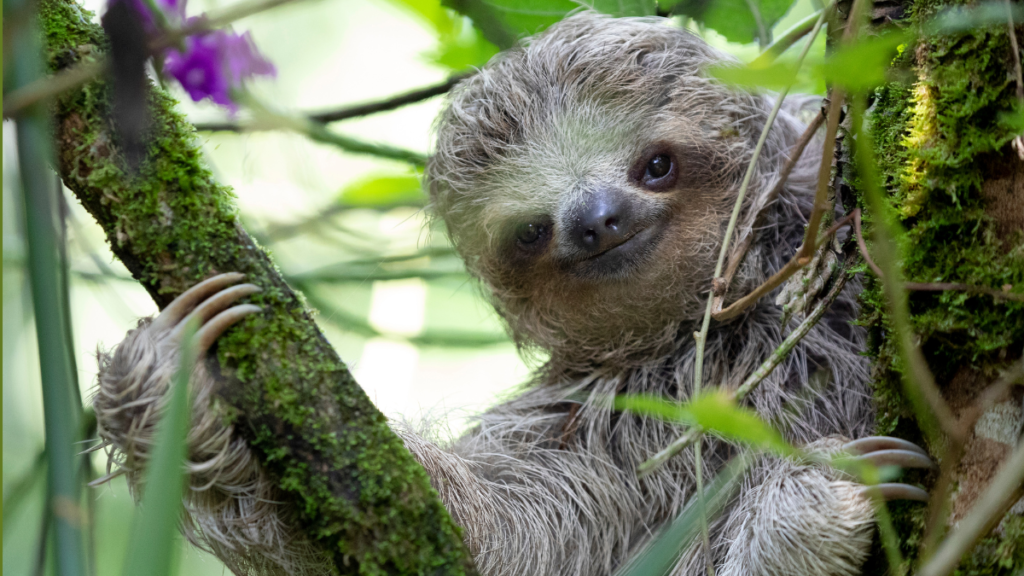The history of sloths is fascinating, as these unique creatures have evolved and adapted to their environment over millions of years. Sloths belong to the order Pilosa and are divided into two families: two-toed sloths (Megalonychidae) and three-toed sloths (Bradypodidae).
The extinct ancestors of sloths could reach the size of an elephant and were too heavy to spend significant time in trees. Instead, they lived on the ground, where they dug large burrows.
Here is a brief overview of the history of sloths:
Ancient ancestors: Sloths have ancient roots dating back to the Eocene, which began approximately 56 million years ago. Fossil evidence suggests that sloth-like ancestors lived in what is now South America at that time.
Diversified evolution: Over millions of years, sloths diversified into different species, some of which were much larger than today’s sloths. Ancient sloths like the Megatherium and Eremotherium were massive terrestrial herbivores that lived during the Pleistocene epoch, which lasted from about 2.6 million to around 11,700 years ago.
Migration to Central America: Sloths gradually migrated northward from South America. Today, the majority of sloth species are found in Central and South America, with a few species extending into parts of North America.
Arboreal adaptations: Sloths are known for their unique adaptations to arboreal (tree-dwelling) life. They have long, sharp claws and are excellent climbers. Their slow metabolism allows them to conserve energy, and they spend most of their lives hanging upside down from tree branches.
Extinction of megafauna: Large terrestrial sloths like the Megatherium disappeared along with many other megafauna species at the end of the Pleistocene, likely due to a combination of climate changes and overhunting by early humans.
Survival of modern sloths: Today, there are six species of living sloths, both two-toed and three-toed. These modern sloths are much smaller than their ancient counterparts and have adapted to their specific habitats in the tropical forest.
Conservation challenges: Modern sloths face various challenges, including habitat loss due to deforestation, as well as threats related to poaching and the illegal pet trade. Some sloth species are classified as vulnerable or endangered.
Pop culture: Sloths have gained popularity in recent years due to their seemingly relaxed nature and slow movement. They have become symbols of relaxation and have been featured in many documentaries and internet memes.
So, sloths have a long and fascinating evolutionary history spanning millions of years. From their ancestors to their current arboreal adaptations, sloths have adapted to life in the forests of Central and South America, facing both natural and human challenges along the way.


Today, there are two different families of sloths: two-toed sloths and three-toed sloths. Besides the number of claws they have, the two types can also be distinguished by their faces. Two-toed sloths have larger eyes and lighter, shaggier fur, while three-toed sloths have the famous dark marks on their faces that give them the appearance of always smiling.
Between the two families, there are a total of six sloth species. They mainly inhabit South America, including Brazil, Venezuela, Colombia, Peru, and Bolivia. However, some of them live further north in Costa Rica and Panama. Sloths are confined to a specific type of habitat: lowland tropical rainforests. They spend the majority of their time in the canopy of tropical forests, using trees as a source of food and shelter.

The Megatherium americanum was one of the largest terrestrial mammals to have ever existed, with a mass that could reach up to 4 tons and a body length of over 6 meters.
Despite its impressive size, the Megatherium americanum was a slow and placid animal, largely due to its arboreal lifestyle. It is likely that it spent a lot of time in trees for feeding and resting. This giant sloth species went extinct at the end of the last ice age, approximately 11,700 years ago, probably due to climate changes and environmental alterations that affected its food source and habitat.
The Megatherium americanum is now extinct, but its fossilized remains and archaeological discoveries provide valuable information about the prehistoric fauna of South and Central America.
To have a memorable Sloth Discovery during your visit to Costa Rica, simply contact COSTOUR at INFO@COSTOUR.CO.
- IKEA arrive au Costa Rica et au Panama
- A Small Nation, a Great Talent: The Story of Luis Castillo-Briceño
- Voyager en sécurité : votre guide essentiel au Costa Rica
- Enhanced Safety in Costa Rica: A New 9-1-1 Center Dedicated to Tourists
- Sécurité renforcée au Costa Rica : un nouveau centre 9-1-1 au service des touristes


